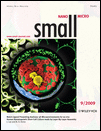A Microwell Array Platform for Picoliter Membrane Protein Assays
Abstract
A novel microwell chip is developed that can be used to detect protein binding in a liquid environment, together with a liquid handling system that allows the performance of assays with picoliter volumes. A PDMS well structure is cast on a planar optical waveguide, providing reaction containers combined with a high-sensitivity fluorescence readout system. Individual wells of the array can be addressed, filled, and rinsed using a contact-mode pin and ring spotter. This allows for immunoassays in a heavily multiplexed way, as all steps of the assay can be individually chosen per well. An array density of over 1000 wells cm−2 is used for the current experiments. The wells provide a protected liquid environment in which the handling of proteins in their natural state is possible, thus maintaining their activity. The membrane protein annexin V is chosen as a model protein to demonstrate the current possibilities. Annexin V binds to phosphatidylserine (PS) head groups of lipids in a Ca2+-dependent manner and is often chosen as a marker for cell apoptosis. Lipid vesicles with and without PS are spotted in individual wells and spontaneously formed a planar lipid bilayer on the bottom of the buffer-filled wells. Annexin V can be used to distinguish between wells containing PS groups previously incorporated in the membrane patches and reference wells without PS head groups. Also, the dependence on the calcium concentration can be shown. Fluorescence readout of the assays is performed using a highly sensitive system based on a planar optical waveguide.




